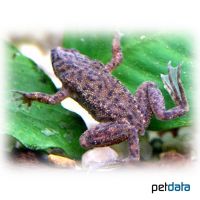Congo Dwarf Clawed Frog (Hymenochirus boettgeri)
| Congo Dwarf Clawed Frog Hymenochirus boettgeri | |
|---|---|
| Name | Congo Dwarf Clawed Frog |
| Name Lat. | Hymenochirus boettgeri |
| Family | Tongueless Frogs |
| Family lat. | Pipidae |
| Order | Frogs & Toads |
| Order lat. | Anura |
| Origin | Central & Western Africa |
| Habitat | Ponds |
| Diet | Carnivore |
| Behavior | Predatory |
| Keeping | Group |
| Care Level | Moderate |
| Breeding | Moderately difficult |
| Housing | Aquarium |
| Life Span | 3-5 years |
| Protection | No |
| Metric Units | |
| Size | 3-4 cm |
| Temperature | 20-30 °C |
| Housing Size | ~ 40 l |
| US Units | |
| Size | 1.2"-1.6" |
| Temperature | 68-86 °F |
| Housing Size | ~ 10 gal |
Distribution and habitat
The home of Böttger's dwarf clawed frogs are warm jungle pools and heavily weedy shallow waters in Central and West Africa.
Maintenance
For 1-3 animals, the minimum aquarium area is 1,250 cm² with a minimum water level of 25 cm. This corresponds to a base area of e.g. 50 x 25 cm. For each additional animal, an additional 300 cm² of surface area must be provided. The aquarium should be placed in a quiet place without sunlight.
They need a partly densely planted aquarium with some plants flooding to the water surface as well as roots, clay tubes and stone structures (caves) as hiding places. A substrate of sand or fine gravel and some subdued light (floating plants) is ideal
Water quality must be that required for average freshwater fish keeping. No ammonia, ammonium and nitrite should be detectable and the nitrate value should not exceed 100 mg/l. To ensure water quality and oxygen content, a filter adapted to the size of the aquarium is required.
| Water temperature | 20-30 °C |
The lighting has to correspond to the species-appropriate day-night rhythm.
Diet
They prefer live food, such as tubifex, mosquito larvae, daphnia and enchytraea, which are also well accepted frozen, plus commercially available frozen special food mixtures, supplemented with a high-quality, protein-rich dry food (granules, flakes, pellets).
Only as much should be fed as is eaten within a few minutes. Regular and varied feeding promotes health and prevents deficiency symptoms
Behaviour and compatibility
They should be kept in a group where females outnumber males. They are predatory and can be a danger to small fish, on the other hand they are endangered even with larger, aggressive fish.
Reproduction and breeding
Females are somewhat stockier and the stub tail is slightly longer than in males. Mating males can be recognized by their bulging postaxillary glands below the axillae.
When the female spawns at the water surface, the eggs (100-500 pieces) are simultaneously inseminated by the male. For rearing, frogspawn should be placed in a separate breeding tank, as the parents eat spawn and larvae. After 1-2 days the larvae hatch and swim freely after 3-6 days. The transformation (metamorphosis) is completed after about 2 months.
The young must be fed several times a day with special rearing food. In a community tank breeding is hardly possible, because the young are easy prey.
The life expectancy can be 10-15 years.
Important
They live permanently under water (aquatile) and do not go on land. To breathe, they come to the water surface. The aquarium must be very well covered so that they do not escape
Like all amphibians, they are alternately warm (poikilothermic), unable to regulate their own body temperature, but adapt themselves and their metabolism to environmental conditions. They molt every few weeks and the skin should be removed from the aquarium if not eaten.
The well-being of the animals should be monitored regularly. Temperature should be checked daily, pH, hardness and nitrate levels at least every 14 days. Regular partial water changes are recommended, even if the pollutant level has not yet reached the upper limit. Sudden changes in water quality should be avoided. Newly introduced animals must be accustomed slowly to the water in the aquarium.
Further literature can be found in your pet store.
References
Text: petdata; Image: petdata
Source: ENGELMANN (2006): Zootierhaltung - Tiere in menschlicher Obhut: Reptilien und Amphibien, Harri Deutsch Verlag; VDA & DGHT (2006): Haltungsrichtlinien für die Haltung von Anuren
- Gemäß § 21 Abs. 5 Tierschutzgesetz idgF
